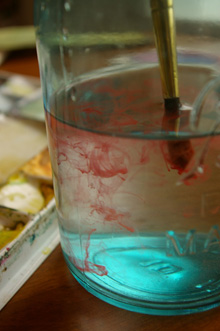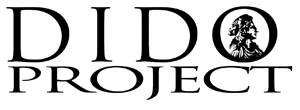

VOCABULARY
Discussion-based learning, such as that offered by Visual Thinking Strategies and other viewing guides, offers opportunities to reinforce terms associated with art. Here are useful terms to incorporate in your class discussion.
Elements and Principles
The following words can be used when talking about the basic design components an artist considers when crafting a work of art.
Background: The space or scene in a work of art that appears to be furthest away from the viewer.
Color: A phenomenon of light that enables the eye to distinguish one object from another.
- Complementary: Pairs of colors directly opposite each other on the color wheel (e.g. red and green).
- Primary: Red, yellow, and blue - the colors from which all the other colors are derived.
- Secondary: Orange, green, and purple - colors mixed from two of the three complementary colors.
- Warm Colors: Reds, yellows, and oranges tend to push their way forward in a composition. These colors are energetic and eye catching.
- Cool Colors: Greens, blues, and purples tend to linger in the middle ground and background. These colors are typically restful and calming.
Composition: The artist's playing field where he or she uses form, color, value, and line to direct viewers to a focal point in a work of art. Form, color, and line are arranged on the picture plane or in the sculpture to lead the viewer's eyes.
Contour: The outside line of a form depicting its shape.
Depth: The illusion of space created by overlapping forms and positioning forms higher in the composition as well as away from the foreground. For more specific information see "Perspective."
Figure: Representation of a human form.
Focal Point: The place the viewer's eye is immediately drawn to. An artist uses elements, such as line and color, to emphasize this particular spot.
Foreground: The space or scene closest to the viewer.
Foreshortening: As forms recede to the background they appear to decrease proportionally in size at a diagonal. By shortening or lengthening forms and placing them at an unusual angle, artists create the optical illusion of a three-dimensional space on a two-dimensional surface.
Gesture: Quick, sweeping movement used by the artist to define a shape or create a line with a pencil, charcoal stick, or other drawing tool.
Geometric Shape: A basic shape such as a rectangle, circle, triangle, etc.
Horizon Line: A horizontal line where land appears to end and sky seems to ascend in a two-dimensional work of art.
Hue: The common name of a color (i.e. red, green, yellow, etc.).
Line: The path of a moving point. A line can be actual (i.e. edges, contours, or outlines), implied (i.e. broken lines, dotted lines), or psychic (a hand pointing or eye gazing, directing the viewer to a focal point).
Medium: The material used to create art (e.g. oil paint, metal, red clay, marble, etc.).
Negative Space: The area surrounding a shape or form in art. Negative space is a key component of sculpture, graphic art, and photography, as it provides contrast and definition to forms and figures.
Organic Shape: A shape resembling living things which may be irregular in form.
Perspective: A scientific technique used to create the illusion of three-dimensional space and depth.
- Aerial Perspective: The expression of space by gradating value, color, and detail. Objects that appear closer will be richer in color, stronger in value, and more distinct in detail. As objects recede into the background, their value, color, and detail will decrease.
- Linear Perspective: Drawn or imagined lines intersecting at a point on the horizon line determine the relative shape, size, and position of objects.
- Two-Point Perspective: This technique of conveying space is the same as Linear Perspective except that it uses two points of intersection on the horizon line instead of one.
Portrait: An artistic representation of a person.
Texture: The way an object feels or appears to feel if you were to touch it.
Art Lingo
Sometimes finding the right word to describe a work of art can be tricky. Some terms, such as the word "abstract," have specialized meanings in the context of an art discussion. Take some time to familiarize yourself with these terms.
Abstract: This term is often confused as being synonymous with "non-representational." On the contrary, "abstract" art accentuates a particular visual quality of a particular form by simplifying the form until all that remains is the essential quality important to the artist.
BCE: The abbreviation for Before Common Era, an alternative for the formerly used Before Christ (BC). BCE denotes the first period on the Gregorian Calendar, which includes pre-history and much of antiquity.
CE: The abbreviation for Common Era, an alternative for Anno Domini (AD; latin for "The Year of Our Lord").
Circa: The Latin term for "in approximately" or "around." This term is used in historical writing when dates are not exactly known. A common abbreviation is "c."
Contemporary: The term used to describe art made after the 1960s. Movements considered to be Contemporary include Pop Art, Minimalism, Conceptual Art, and Neo-Expressionism.
Exhibition: A space arranged for a limited time to display selected works that pertain to a particular idea or theme.
Flat: The illusion of no volume and depth in a work of art. In a two-dimensional composition, an area of pure color, without shadow or highlight, will appear flat.
Modern and Modernism: Modern identifies art made during the late 1800s and early 1900s. Modernism is also used to describe art during this time, but it more specifically concerns the ideas associated with this art. Movements during this time include Post-Impressionism, Fauvism, Cubism, Expressionism, Surrealism, Dada, and Abstract Expressionism.
Non-Representational: Art wherein subject matter bears no resemblance to visual reality.
Object: Any work of art in BSU Museum of Art.
Plane: A two-dimensional surface with defined boundary.
Realism: Realism was a movement during the second half of the nineteenth century that presented a frank portrayal of everyday life.
Static: When compositional elements — such as line, color, and shape — are arranged to reduce visual movement, the composition appears still and stiff.

